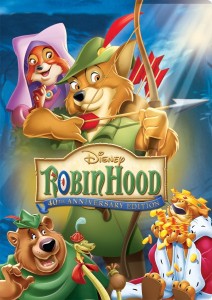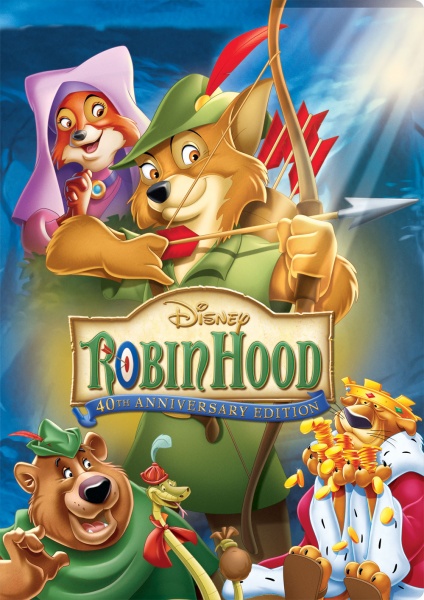
The 21st full-length animated feature in Disney history, Robin Hood was released on November 8, 1973. The film, which was based on the English folk story of the same name, is 83 minutes in length.
Plot Summary
In England, the good King Richard has gone on a crusade to the Holy Land, leaving his brother, Prince John, in control of his territory. Unfortunately for the masses, John and his regime are greedy and arrogant. They’re all about glory and power, and they show no mercy towards the people of Nottingham.
All’s not lost, however, for the citizenry. Hope exists in a charming fox named Robin Hood, who, aided by his sidekick Little John the bear, steals from the rich—seemingly only Prince John in the film—for the benefit of the poor.
There’s just one problem with the title character: he’s a wanted man…err, fox. Can he continue to escape the grasp of the evil Prince?
Villains
Three main villains—Prince John, the Sheriff of Nottingham, and Sir Hiss—wreak havoc in the film.
Prince John heads the corrupt government and is desperate to kill Robin Hood. To this end, he tries to trap the title character by creating events such as an archery tournament and a public hanging for Friar Tuck, which he hopes his nemesis will attend.
Though the Prince may be the primary villain, I found myself to be more angered by the Sheriff. This wolf claims to be a “friendly neighborhood tax collector,” but while he certainly fulfills his tax-collecting duty, he’s far from friendly. He mercilessly takes Skippy Rabbit’s birthday coin as well as a coin from the poor box at the church.
Then, there’s Sir Hiss, a snake who hypnotized King Richard such as to get him to leave for the crusade against his will. As shown by the robbery scene at the start of the film, Hiss is much more discerning of potential trouble than the Prince. Unfortunately for Sir Hiss, Prince John shows him no mercy and will ridicule him even when the snake’s clearly in the right. Lack of appreciation notwithstanding, Sir Hiss remains loyal to the Prince. Even after John threw him off the stand at the archery tournament, Hiss spotted Robin Hood and was going to turn him in until the air literally came out of the snake’s balloon.
Symbolism
While watching the film, I noticed some elements that could be considered symbols for larger themes.
The potential symbol that struck me the most was Prince John’s crown, which won’t stay flat around his head. While the crown literally doesn’t fit John, it also doesn’t fit the Prince in a figurative sense as he’s not worthy of leading the kingdom.
Another possible symbol came during the jail scene. Here, the stormy weather captures the depressed mood currently endured by the indebted people.
Finally, the scene near the beginning of the film where John fell off his runaway carriage into the mud made an impression on me. The inept ruler had hit a temporary rock bottom.
Adventure
While a love story is prevalent in Robin Hood, adventure dominates the film. There are numerous battle scenes, which provide the viewer with action, suspense, and even humor.
The battles occur throughout the movie. There’s a brawl after Robin Hood is discovered at the archery tournament, another after the Sheriff takes the coin from the poor box, and still another at the end of the film when Robin Hood attempts to break the masses out of jail.
Humor further augments the action sequences. To give one example, Robin Hood proposes to Maid Marian just like most people do nowadays: on an unstable tent roof while attempting to get away from Prince John’s army! Well, on second thought, proposing on tent roofs isn’t common these days; if it was, I probably wouldn’t have found the scene funny.
Music
As with The Sword in the Stone (1963), I found the music in Robin Hood to be catchy but forgettable. To be fair, though, the songs from this film weren’t engrained in my head at an early age like those from other flicks such as Snow White and the Seven Dwarfs (1937) were.
Upon commencement, the film almost immediately breaks into song with “Oo-De Lally.” Sung by the narrator, the rooster Alan-A-Dale, this country tune helps set the foundation for the characterization of Robin Hood and Little John.
The movie’s most romantic number is named, appropriately, “Love.” Although the song itself isn’t my favorite, I found the nighttime setting with Robin Hood and Maid Marian having fun in the forest to be touching.
The final major number from Robin Hood is “The Phony King of England.” Performed directly after “Love,” this song ridicules Prince John through both the actual lyrics and visual humor. While most of Nottingham, including the Sheriff, enjoyed this song, Prince John despised it for some strange reason. He was so angry, in fact, that he tripled the people’s tax responsibilities upon hearing it.
In the Parks
Robin Hood doesn’t have a major presence in Disney’s parks. No attractions based on the film exist, and the characters—Robin Hood, Friar Tuck, the Sheriff of Nottingham, and Prince John—make only rare appearances.
Overall
I really enjoyed Robin Hood for its solid mix of action, adventure, romance, and comedy. In some cases, attempting to mesh so many genres in a single film might “spoil the soup,” so to speak, but I think it worked well here. The one problem with the movie is the lackluster animation, which was brought on by a low budget after Walt Disney’s death several years earlier.
What do you think of Robin Hood? Let me know in a comment!
Sponsored Ad: Would you like to help support The Mouse For Less website in continuing their mission of being THE Disney vacation planning resource? You can do so by purchasing Robin Hood from our affiliate link through Amazon.

